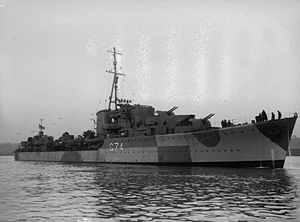This article includes a list of general references, but it lacks sufficient corresponding inline citations. (March 2010) |
 HMS Legion with her Type 285 radar aerials visible on her HA DCT
| |
| Class overview | |
|---|---|
| Operators | |
| Preceded by | J, K and N class |
| Succeeded by | O and P class |
| Subclasses | L, M |
| Built | 1938–42 |
| Completed | 16 |
| Lost | 9 |
| Scrapped | 7 |
| General characteristics as completed | |
| Type | Destroyer |
| Displacement |
|
| Length | 362 ft 3 in (110.4 m) o/a |
| Beam | 37 ft (11.3 m) |
| Draught | 10 ft (3.0 m) |
| Installed power | 48,000 shp (36,000 kW) |
| Propulsion |
|
| Speed | 36 knots (67 km/h; 41 mph) |
| Range | 5,500 nmi (10,200 km; 6,300 mi) at 15 knots (28 km/h; 17 mph) |
| Complement | 190 |
| Sensors and processing systems |
|
| Armament |
|
The L and M class was a class of sixteen destroyers which served in the British Royal Navy during World War II. The ships of the class were launched between 1939 and 1942.
The L class (also known as the Laforeys) were approved under the 1937 Naval Estimates. Four of these ships (Lance, Lively, Legion and Larne) were built with 4-inch (100 mm) armament instead of 4.7 inch. Six of the eight were war losses, with the surviving pair being broken up in 1948.
The M Class were built under the 1939 Naval Estimates. They served in the Home Fleet until 1944 and then went to the Mediterranean. Three were wartime losses; of the five survivors, the Musketeer was broken up in 1955 and the other four sold to Turkey in 1958.